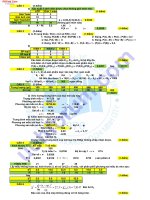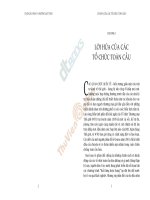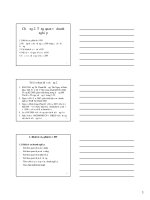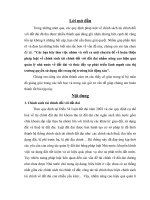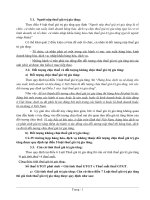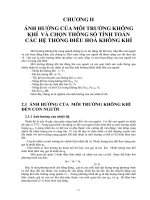2 turing machine (formal definition) mp4
Bạn đang xem bản rút gọn của tài liệu. Xem và tải ngay bản đầy đủ của tài liệu tại đây (78.47 KB, 5 trang )
(00:01)
Hello, everyone.
(00:02)
Welcome to the next lecture.
(00:04)
In the course and theory of Atom meta.
(00:06)
In this lecture we will discuss about the
formal definition of a Turing machine.
(00:12)
In the previous lecture we studied about
the the introduction of a Turing machine,
(00:17)
and now we will see how can we
formally define a Turing machine?
(00:21)
All right.
(00:23)
So Turing machine can be defined
(00:27)
as set of seven tuples, which are Q,
Sigma, Tau, Delta, Q, Naught, B, and F.
(00:37)
Now let us see what these tuples are.
(00:42)
The first one is Q, which is
the known empty set of stats.
(00:47)
So you already know that also in finite
state machine and pushdown Automata,
(00:53)
this Q tuple is used to represent
the non empty set of States.
(00:58)
And then we have Sigma and Sigma.
(01:00)
Also, just like in other machines, it
represents the non empty set of symbols.
(01:05)
Or we can say it is the set of input
(01:08)
symbols that we have
in our Turing machine.
(01:11)
Then we have Tau.
(01:13)
Now Tau is something different from finite
(01:16)
state machine and pushdown Automata, and
it is the nonimplice set of tape symbols.
(01:22)
When we studied the introduction of Turing
machine, we saw that Turing machine has
(01:27)
something known as tape,
and what is a tape?
(01:31)
It is an infinite sequence of symbols.
(01:33)
So these symbols are the tape symbols.
(01:36)
They are represented by this tuple Tau.
(01:39)
So it is non empty set of tape symbols.
(01:43)
And then we have Delta,
which is the transition function.
(01:48)
And we know that transition functions are
(01:51)
also there in finite Automata and push
down Automata, and they are defined
(01:56)
in different ways according
to how the machine works.
(02:00)
So in case of Turing machine,
(02:02)
the transition function is defined as Q
(02:05)
cross Sigma, two Tau, cross R, R cross Q.
(02:13)
Now let us see what this actually means.
(02:16)
We know that in Turing machine we have
(02:19)
States and we have input symbols,
and then we also have the tape symbols.
(02:25)
So here this transition function means
that if we are in a particular state
(02:30)
and we get a particular input symbol,
then we write something into the tape
(02:35)
sequence and we move either
right or left on the tape.
(02:40)
And then we go to the next step.
(02:43)
So this is what we mean by the transition
function Delta in a Turing machine.
(02:49)
This will be more clear to you when we
(02:51)
will take our examples
in the next lecture,
(02:54)
and then we have Q naught,
which is the initial state.
(02:58)
Also, we have B, which is a plank symbol.
(03:02)
So in introduction to Turing machine,
(03:04)
I told you that in the tab we have
a special symbol card blank symbol,
(03:10)
which is used to fill the empty
cells of a Turing machine.
(03:14)
Also, this empty symbol does not belong
to the set of symbols Sigma,
(03:20)
and then we have F,
which is the set of final States.
(03:25)
So also in introduction,
I told you that there are two kinds
(03:29)
of final States in Turing machine
that is accepted and reject state.
(03:35)
So these are the seven tuples that are
used to define a Turing machine.
(03:40)
Now let us discuss
the production rule of a Turing machine.
(03:47)
Thus, the production rule of Turing
machine will be written as
(03:52)
the input argument,
which have two arguments Q naught and A,
(03:59)
and then the output have three
arguments Q one, Y and R.
(04:05)
So what does this mean?
(04:07)
This means that if we are in the initial
state Q naught, and if we get input symbol
(04:13)
A, then we go to another state Q one,
and we write the input symbol Y onto our
(04:20)
tab and we move to the right
or left on our table.
(04:24)
Here it shows that we move to the right.
(04:29)
So it was all about the formal
definition of a Turing machine.
(04:34)
In the next lecture,
we will take two examples
(04:38)
where we will construct Turing machines
(04:40)
for languages which we will
discuss in the example.
(04:46)
So thank you for watching
and see you in the next lecture.
